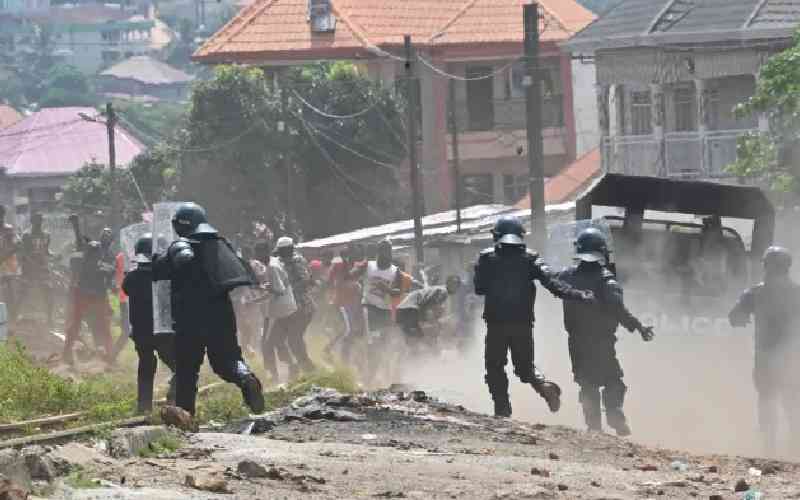 |
|
Technicians of Cortec Limited on site at Mrima Hills in Kwale before they struck Niobium and other rare earths. [Photo: Tobias Chanji/Standard] |
By Mark Kapchanga
Kenya: Kenya could join the league of Algeria, Egypt, Libya and Zimbabwe in steel production following the discovery of key ingredients that make up the mineral.
According to the Geology and Mines Department, the ingredients, mainly the rare earth minerals in Kwale, coal and iron ore could put the country on a global pedestal as it stands to contribute over 13 per cent of the total Gross Domestic Product.
“The recently discovered rare earth minerals in Kwale, whose value now stands at more than Sh51.2 trillion completed the unbalancing equation we have strived for ages to work on,” said a source at the Geology and Mines Department.
Coal mining is expected to start in Mwingi soon. It is estimated that about 400 million tonnes of coal is deposited in the area.
The neighbouring Tharaka has also been discovered to have potential for the production of iron. The tendering for coal exploration was completed two years ago by the energy ministry and was awarded to a Chinese company at a cost of over $1 billion (Sh85 billion).
Local deposits
Industrial progress and economic growth that has seen significant development in housing, transport facilities, water distribution, industrial premises and agricultural mechanisation has spiked demand for steel.
The private sector has over the years invested over Sh5 billion in fixed assets for the production of steel products.
However, the industry is heavily dependent on imported raw materials due to lack of local sourcing.
“Local deposits of iron ore have been identified in the country but have not attracted commercial interest,” said Johnstone Wachira, a researcher at the mining ministry.
“Through imports of raw materials and local scrap collection, a sizeable and a growing local capacity has developed to cater for both export and domestic market,” he said. According to Dr Wachira, the existing deposits have not been commercially exploited, hence the manufacturing activities in this sector is classified under secondary production.
“Locally-sourced scrap metal is smelted to produce steel billets. The billets are further rolled into reinforcement steel bars for use in construction industry.”
For the production of special products like screws, bolts and nuts, nails and rivets, the local steel mills have to import quality billets.
In 2009, Africa produced 15.2 million metric tonnes, accounting for 1.3 per cent of global steel production. This was the lowest level in the continent in six years.
Stay informed. Subscribe to our newsletter
Experts say construction industry is the largest consumer, accounting for approximately 50 per cent of total steel consumption in Kenya.
Transport sector such as cars, trucks, aviation, shipbuilding and rail is the second while machinery industry and metal products industry each consume around 14 per cent of the world’s steel.
The output of construction market amounts to around $7.5 trillion, representing 13.4 per cent of global GDP. The US is the largest market and China is the second.
Growth in China has been driven by non-residential structures and infrastructure.
World Steel Association says steel demand is expected to grow by 3.2 per cent this year, but it would depend on recovery in key markets like China and euro-zone economies. For the current year, it has forecast a growth of 2.1 per cent, which is considerably lower than that of 6.2 per cent growth of 2011.
Economic recovery
“We expect the situation to gradually improve on the basis that the euro-zone crisis has been contained, the US successfully deals with the fiscal tightening due this year and the economic stimuli measures secure a soft landing in China,” said David Matt, the firm’s executive director.
According to the outlook, demand in China, the growth engine for world steel consumption, is expected to increase by 2.5 per cent to 639.5 metric tonnes during the current year.
The East-Asian country, which had reported a growth of 6.2 per cent two years ago has been witnessing a slugged demand this year.
India will witness a five per cent growth, a slight dip from last year’s “due to both unfavourable domestic and external economic conditions”. In Europe, however, a growth of 2.4 per cent growth will be recorded.
The news on Kenya’s potential to produce steel comes amid reports that ArcelorMittal South Africa is focusing on expanding its market share in neighbouring countries where demand is robust.
Kenya in particular has been put on the firm’s radar due to its expansive development in infrastructure such as rail, roads and energy.
ArcelorMittal’s plan to exploit opportunities in the rest of Africa comes after a huge loss it made between this January and June.
The dismal performance was as a result of declining demand for steel in South Africa as a result of a slump in construction, slower-than-expected infrastructure investment by the government and weak mining sector production.
During the period, exports were down 40 per cent while domestic shipments dropped seven per cent. Flat steel shipments fell 20 percent and long steel volumes were down nine per cent, the company said.
The company would grow its market share by up to 45 per cent in neighbouring southern African countries and in Rwanda, Kenya and Tanzania,” said chief marketing officer Sunil Kumar.
He noted that there had been significant growth in the past couple of years in the rest of Africa. “East Africa remains a strategic market for us,” Mr Kumar said.
Growing demand
The subsidiary of the largest global steel producer planned to beef up exports to southern African countries from 750 000 tonnes to 1.1 million tonnes. It expected to improve supply in East Africa from 600 000 tonnes to ten million tonnes a year.
Figures indicate that demand for steel in Uganda stands at 150,000 tonnes per year, which is more than double the 60,000 tonnes produced annually.
The steel industry has been growing at a rate of 30 per cent for imports and decelerating at 40 for exports per year.
Players in the sector say the high costs of production and the prevalence of cheap steel imports from countries such as China, India and Japan.
Narendra Jain, the chief executive officer at MM Integrated Steel, said the steel industry in Uganda is not yet fully developed and players are still grappling with the challenge of imported steel.
“The cost of doing business in steel exporting and producing countries is relatively low compared to that in Uganda since we are a land locked country,” said Jain.
“For the steel industry to grow in Uganda, there needs to be value addition aimed at encouraging local production. By August, we hope to embark on full capacity production and we are confident of producing 40,000 tonnes of quality sheet per annum,” Jain said.
In September last year, it was reported that China Machine Building International would build a $100 million iron ore mining and integrated steel plant in Mbarara.
“We need a steel industry very badly because the Government does a lot of construction works,” President Yoweri Museveni said.
Uganda has reserves of iron ore in excess of 100 million tonnes in the eastern and south western regions of the country.
Despite its huge potential, estimated at 13 per cent of the Gross Domestic Product, the sector faces numerous upheavals. For instance, it is very costly to off load and clear steel at the Mombasa port.
Undue advantage
On average, one spends Sh2,952 compared with Sh720 in more efficient ports such as Singapore. “This can be very costly bearing in mind that the steel raw material is usually transported in thousands of tonnes.
Cases of loss of cargo also exists and adds to already cited inefficiencies which ultimately make our local manufacturers un-competitive,” said Dr Wachira.
 The Standard Group Plc is a
multi-media organization with investments in media platforms spanning newspaper
print operations, television, radio broadcasting, digital and online services. The
Standard Group is recognized as a leading multi-media house in Kenya with a key
influence in matters of national and international interest.
The Standard Group Plc is a
multi-media organization with investments in media platforms spanning newspaper
print operations, television, radio broadcasting, digital and online services. The
Standard Group is recognized as a leading multi-media house in Kenya with a key
influence in matters of national and international interest.
 The Standard Group Plc is a
multi-media organization with investments in media platforms spanning newspaper
print operations, television, radio broadcasting, digital and online services. The
Standard Group is recognized as a leading multi-media house in Kenya with a key
influence in matters of national and international interest.
The Standard Group Plc is a
multi-media organization with investments in media platforms spanning newspaper
print operations, television, radio broadcasting, digital and online services. The
Standard Group is recognized as a leading multi-media house in Kenya with a key
influence in matters of national and international interest.









